Iraq remembers Samarra bombings
Blasts ripped through the al-Askari Mosque a year ago triggering sectarian conflict.

Though the third holiest Shia site in the world, Al-Askari Shrine stood proud in a predominantly Sunni town.
Sunni extremists were immediately blamed for the blasts. A couple of hours after the blasts, a sectarian war was unleashed across a shaken Iraq.
The war moved to the streets of the capital Baghdad, leading George Bush, the US president, to admit failure and change US tactics in Iraq.
Exactly one year later, 90,000 US and Iraqi troops are pouring into the capital in a massive security plan called “Operation Imposing Law and Order”. It is the third such crackdown. The task is daunting and there is no guarantee of success.
The Samarra blasts traumatised Iraqis. “We still want to know what happened. Our city has taken care of the shrine for more than 1000 years. Nobody dared to touch it. Had anyone thought about how it will affect us,” a Sunni Iraqi in Samarra wondered aloud.
Importance
Samarra is a predominantly Sunni city and the Askari Shrine falls under the Sunni Endowment, a government body that caters to the needs of Sunni mosques and religious establishment throughout the country.
The compound contains the tombs of the 10th and 11th imams – Ali al-Hadi, who died in 868, and his son Hassan al-Askari, who died in 874.
Both are descendants of the Prophet Muhammad, and Shia consider them to be among his successors.
Samarra is also the site of the disappearance of Muhammad al-Mahdi, the 12th and last imam also known as the “hidden Imam”.
Muhammad al-Mahdi is the son and grandson of the two imams buried in the Askari Shrine. Shia believe he will return to earth to restore justice to humanity.